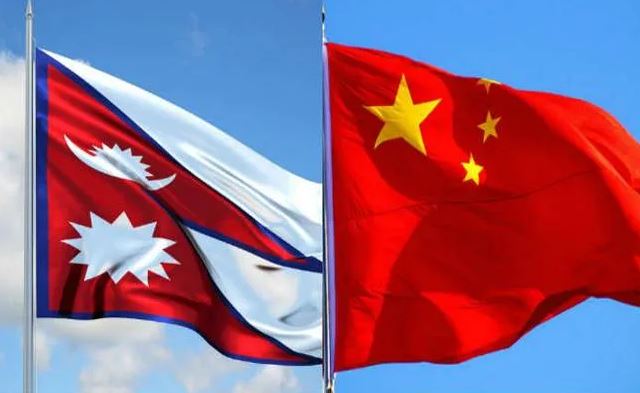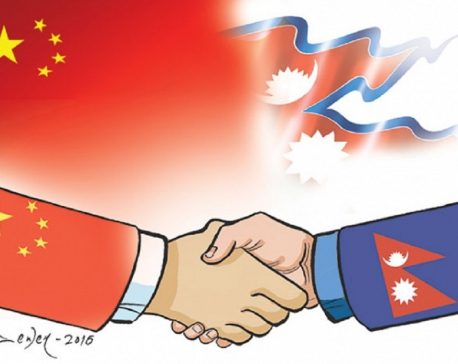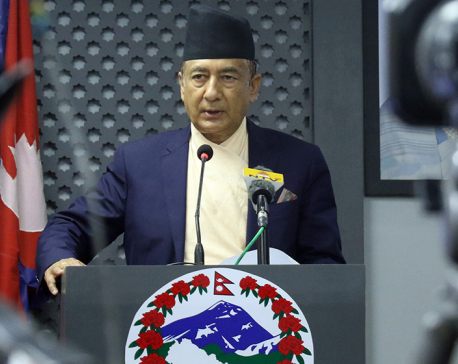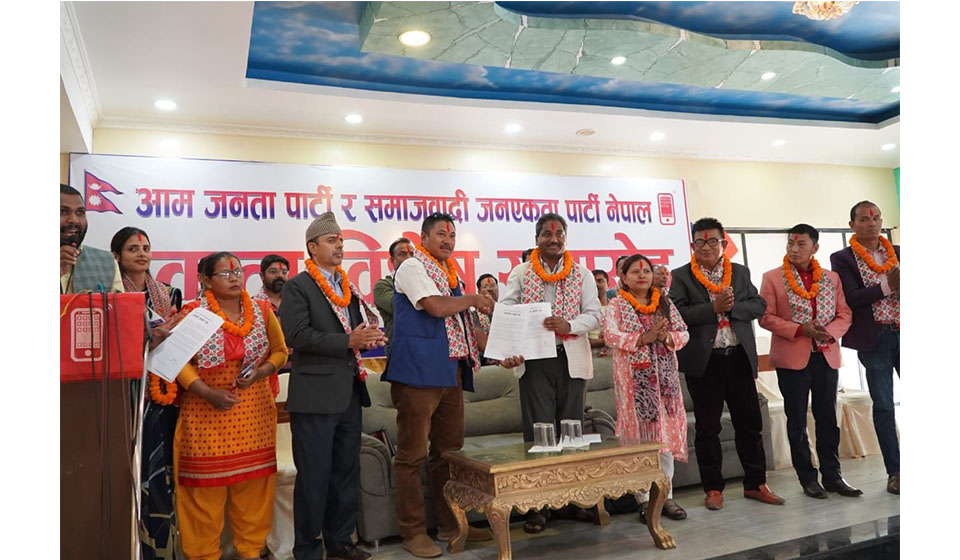
OR
Opinion
Why does Nepal matter for China?
Published On: October 1, 2023 08:45 AM NPT By: Hari Prasad Shrestha

More from Author
- Why Federalism has Become Risky for Nepalese Democracy
- Hunger is a Serious Problem in South Asia
- Tourism Can Be A Catalyst For Change in Karnali Province
- Nepal’s Southern Border Has Become An Open Regional Crossroads
- Opening a new gateway for Kailash Mansarovar Yatra through Nepalgunj-GunshaNagari flight
Nepal has historically strong relations with China. In fact, many Nepalis have little knowledge about Nepal’s relation with Tibet and that it was easier and safer compared to travel towards the south, at least until the 19th century. Sociologist Dor Bahadur Bista mentions that until the beginning of the 19th century, Nepal shared a greater cultural affinity with and had more significant economic interest in Tibet. Also, there were more Nepalis in Tibet than anywhere else in South Asia. By that time, Nepalis were more privileged in Tibet. Nepalis businessmen could marry Tibetan women, and male offspring of such marriage was regarded as Nepali subjects (popularly known as Khachara) whereas a female child from such a marriage (Nepali father and Tibetan mother) was acknowledged as a Tibetan citizen.
Once, Kathmandu was a prime center of trans-Himalayan communications and a meeting ground of traders of Nepal, British-India, and Tibet. People from major bordering points i.e. Kerung, Kuti were active in trade, tourism, and trekking related businesses. There were no restrictions on human movements to and from Tibet to Nepal. However, drastic paradigm shifts were observed on aspects of human mobility after occupation of Tibet by China and deployment of an Indian military mission in Nepal-China border in the 1950s and unabated migration of Indians into Nepal’s Terai region, after the 1950 Indo-Nepal Treaty of Peace and Friendship.
Before the Sino-India war, Nepalese used to travel through the ancient Silk Road as a means of greater regional connectivity. Nepalese merchants used to conduct trade between Nepal, Tibet and Bengal, India over the Silk Road, and acted as a bridge for economic and cultural exchanges between South Asia and Central Asia. The thousand-year-old Lhasa Newar tradition came to an end after the caravan route linking India and Tibet through Sikkim was shut down by the Sino-Indian War in 1962.
Around 600-650 CE, Nepalese Princess Bhrikuti got married to Songtsan Gampo, the Emperor of Tibet. Princess Bhrikuti, as a part of her dowry, brought Buddhists relics and Thangkas to Tibet and established Buddhism as the Royal religion in Tibet. Bhrikuti is usually represented as Green Tara in Tibetan iconography. The Red Palace on Marpo Ri (Red Mountain) in Lhasa, which was later rebuilt into the thirteen story Potala Palace by the Fifth Dalai Lama, was constructed by Newari craftsmen.
In 1260 CE during the Yuan dynasty, Araniko, a craftsman of Nepal, on the decree of Chinese/Mongolian Emperor Kublai Khan, traveled to Shangdu and built the White Stupa of Miaoying Temple in Beijing, which was the largest structure in Beijing at that time. Taking almost ten years (1279-1288 CE) to complete, the Stupa better known as White Dagoba is still standing today and is one of the oldest Buddhist Stupa in China.
The Kerung route was opened in the 17th century which provided the ground to develop a closer interaction among China, Tibet, India, and Nepal. It was Tibet, which was paying an annual tribute of Rs 10000.00 to Nepal until 1953. Moreover, Nepalese were freely allowed to visit pilgrimages to the holy Mt Kailash in Tibet. Likewise, Tibetans were allowed traveling to worship Buddhist temples in Nepal.
In the changed current modern context, three important developments have deepened and widened Nepal-China bonds. The first is the economic blockade of 2015 along the Nepal-India border, the second is the Belt and Road Initiative (BRI) undertaken by China, and the third is China’s rise as the second most important global economic, military and political power.
Nepal is important for China due to its geopolitical location between India and China. During visits of Nepali Prime Minister KP Sharma Oli to China in 2015 and 2018, the two countries agreed to implement the memorandum of understanding (MOU) on the BRI to enhance connectivity in key areas including ports, roads, railways, aviation and communications within the framework of Trans-Himalayan Multi-Dimensional Connectivity Network. China agreed to provide four sea ports and three land ports (dry ports) to Nepal.
During the recent visit of Prime Minister Pushpa Kamal Dahal to China, both countries reiterated to speed up projects under BRI. Prime Minister Dahal, who flew to Hangzhou from New York to witness the inaugural session of the Asian Games, as per media reports, has told Chinese President Xi Jinping that his government will further promote the Trans-Himalayan network as it will “greatly assist” Nepal’s national economic development. The Trans-Himalayan network, an economic corridor between Nepal and China, is part of the BRI. Moreover, discussion with Chinese President Xi Jinping and Premier Li Qiang on various dimensions of Nepal-China bilateral relations was a worth-noting moment for confidence building.
During his visit, a 13-point memorandum of understanding (MoU) was signed and exchanged including 10 agreements and 3 MoUs related to various sectors including agriculture, communication, science and technology, and trade. Moreover, increasing productivity in the northern region of Nepal, digital economy corporation, green and low carbon cooperation, as well as translation and publication of ancient texts are other subjects of agreement. Establishing a joint technical working group and cooperation in the field of science and technology and innovation are other subjects of agreement. Moreover, an agreement on the construction of a 220 kV cross-border transmission line between Nepal-China under Power Grid Interconnection Project (Chimile-Kerung), which will be built through a Chinese grant, would open the door for power trading with China.
However, looking at these lists of agreements, it is clear that the visit was more of a formality than excitement. None of the agreements involved Belt and Road Initiative (BRI) projects. Moreover, formally PM Dahal did not raise the issue of the new map of Nepal during his visit to China. The joint statement of two countries has included almost all necessary sectors full of promises and it lacks concrete roadmaps for implementation of the projects.
However, the Chinese financial and technical assistance to Nepal has greatly contributed to Nepal’s development efforts in the areas of infrastructure building, industrialization process, human resources development, health, education, water resources, sports and the likes. Currently some of the major projects under Chinese assistance include: Upper Trishuli Hydropower Project- Power station and Transmission Line Projects, Food/ Material Assistance in northern 15 bordering districts, Kathmandu Ring Road Improvement Project, Larcha (Tatopani) and Timure (Rasuwagadhi) Frontier Inspection Station Project, Pokhara International Regional Airport, Upgradation of Syaprubensi- Rasuwagadhi Road, Upgradation of Civil Service Hospital and Upgradation of Kodari Highway and restoration of bordering bridges at Kodari and Rasuwagadhi.
Lastly, the China policy towards Nepal is stable and free of complications. There are no disputes between the two countries. The bilateral relations between Nepal and China have been friendly and defined by Nepal’s policy of balancing the competing influence of China and Nepal’s southern neighbor. Moreover, China has an unchanged policy towards its gainful investment, one China policy and it is against disturbances through Nepal to Tibetan territory. It is less concerned with other than these issues and always deals with Nepal respecting it as a sovereign nation based on equality and non-interference.
You May Like This

As Nepal and China celebrate 65 years of friendship, a great deal of work lie ahead of us
The Federal Democratic Republic of Nepal and the People’s Republic of China are celebrating 65 years of the establishment of... Read More...

A Promising Leap in Energy Market Diversification
In a significant development, Nepal and China have inked a commitment to move ahead with the construction of the Jilong-Keyrung-Rasuwagadhi-Chilime... Read More...

Govt approves several Chinese proposals
KATHMANDU, March 29: The government has decided to approve the grant assistance and the technical assistance related to the feasibility... Read More...


Just In
- Sunkoshi-Marin Diversion Project’s tunnel construction nears completion, breakthrough scheduled for May 8
- Govt tightens security arrangement for Third Investment Summit 2024
- Pesticide residue found in vegetables in Nepalgunj
- Aam Janata Party and Samajwadi Jana Ekata Party merge
- 1,600 participants confirmed for Nepal Investment Summit
- Ilam-2 by-elections held peacefully, vote count likely to start tonight
- NEA schedules five-day power cut across Kathmandu Valley for underground cable installation
- Hundreds of passengers including foreign tourists in distress as poor visibility halts flights to and from PRIA








-1200x560-wm_20240427144118.jpg)






Leave A Comment